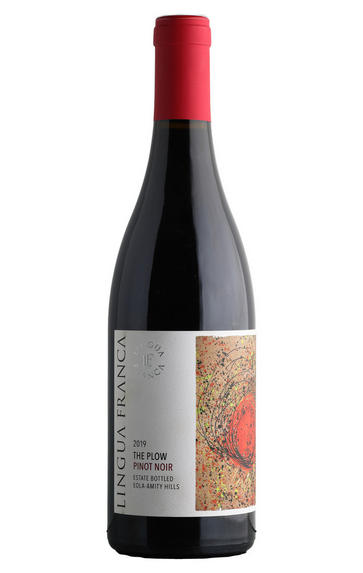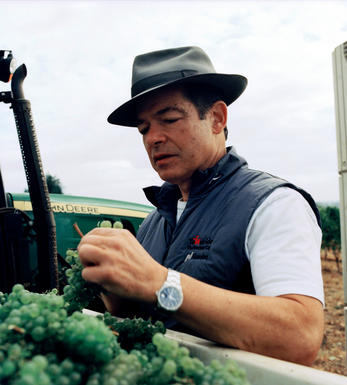
2019 Lingua Franca, The Plow, Pinot Noir, Eola-Amity Hills, Oregon, USA

Critics reviews
Deep magenta. Expansive red and dark berry and floral aromas are complemented by hints of star anise, sassafras and cola. Sappy, seamless and fleshy on the palate, offering intense black raspberry, cherry cola, candied lavender and mocha flavours underscored by a vein of smoky minerality. Seductive in character, finishing with powerful thrust and supple tannins that meld smoothly with the sappy, persistent fruit.
The Pinots made by the team headed by Larry Stone (whose resume I won’t bore you with; it’s pretty well known and available on Google) and winemaker Thomas Savre (whose own CV is also quite impressive) have quickly become among the best in the United States. For to my palate, the 2018s show wonderful clarity and no warm-vintage shortcomings, and I’ll wager that the 2019s are the best set of wines yet made here.
In both years, one gets the generous fruit expression that marks the vintages and identifies the wines as “New World.” At the same time, there is distinct tension and focus in play, which confounds such stereotypes. New oak isn’t eschewed by Savre, but when it’s there, I find it well-played: an integral supporting actor, but not a star (think rhythm guitar versus lead). It’s early days to predict where these wines will go with age, but the right boxes (depth, energy, focus, structure and balance) are all ticked, suggesting that the 2018s and 2019s will deliver big dividends down the road.
Drink 2024 - 2034
Josh Raynolds, Vinous.com (February 2022)
Full bottle 1,355 g. Clone 777 planted on particularly promising Blocks 1 and 2 where the soils transition from shallow Geldermann to Jory.
Mid garnet. Quite a rich nose but then appetisingly savoury on the palate. Good grip and follow-through. Some real framework for future development but approachable already. Sappy fruit.
Drink 2021 - 2027
Jancis Robinson MW, JancisRobinson.com (October 2021)
The 2019 Pinot Noir The Plow has inviting aromas of blackberry, cranberry, blood orange, forest floor and star anise. The light-bodied palate is chalky and refreshing with a deep core of floral fruit and a long, spicy finish. It will benefit from another 3-5 years in bottle.
Drink 2025 - 2035
Erin Brooks, Wine Advocate (August 2023)
This superb Chardonnay is produced from the Estate vineyard in the Eola-Amity hills across the street from Seven Springs. 2019 produced a wine with vibrant acidity and a well-developed fruit with a lemon peel and passionfruit nose that is also informed by the full malo and long, reductive aging in cask (20% new). The wine has an elegant balance between the freshness of the vintage and a ripe, dense fruit character that will allow it to age for years to come.
Drink 2021 - 2034
Charles Curtis MW, Decanter.com (February 2022)
The 2019 Pinot Noir The Plow is ripe with raspberry liqueur, cedar, and moss-covered earth. The palate has a wonderfully energetic and persistent drive and fills with grenadine, iron-rich earth, and candied rose. This is another impressive wine from the team at Lingua Franca.
Drink 2024 - 2035
Audrey Frick, JebDunnuck.com (August 2022)
About this WINE

Lingua Franca
Lingua Franca in Oregon is the realisation of a life’s ambition for Master Sommelier Larry Stone. Having bought a site in the Eola-Amity Hills in 2012, Larry joined forces with David Honig and Dominique Lafon to create wines of expression and nuance.
The impressive triumvirate behind Lingua Franca enlisted Lafon’s protégé Thomas Savre as the winemaker, while Dominique supports as a consultant himself. Thomas brought his experience from several Burgundian greats and his time at Lingua Franca’s neighbour Evening Lands where was able to learn from Dominique.
The ethos at the birth of the project was about creating wines which have a sense of place and this is something for which all involved have both passion and expertise.
Larry’s vineyard is 27ha sitting among auspicious neighbours, Seven Springs and Lone Star Vineyards. This is a hillside which Larry rightly judged to have the ideal easterly exposure, catching the morning sunshine and gentle cooling breezes.
Larry has planted exclusively Dijon and heritage clones of Pinot Noir and Chardonnay. These are sourced from specific vineyards whenever possible – cuttings from Le Montrachet for example. The Chardonnay occupies the stoniest soils to bring a distinctive minerality to the wines. The Pinot is found on silty loam “Jory” and marine fossil Nekia soils.
Larry’s enthusiasm for the vineyard was the driving force behind this project so it is perhaps unsurprising that an organic and biodynamic approach is taken in its management. The attention to detail is meticulous and the regime is as much about encouraging biodiversity as it is vine health. The winery has also been built with the environment in mind, with numerous initiatives to reduce energy consumption and reuse water and CO2.
The approach to the wine making is no less scrupulous than the care of the vines themselves. The grapes are first sorted in the vineyard before a second sorting by hand in the winery. Enormous care is taken to ensure that they are kept in perfect condition and only whole grapes make it to the wine. Depending on the vintage there is a proportion of whole clusters used for the Pinot to increase complexity.
Pigéage (punching down) is conducted by foot here, a practice not often seen in wineries these days. Thomas is convinced that this more intuitive approach gives a better result than the mechanised alternative.
The range is made up of the estate wines together with some bought in fruit from single site. These are classic Oregon, always elegant and full of pure fruit but completed with notes of spice and earth which elevate them to give them a true sense of place.

Oregon
While similarities might be drawn between Califonia and Bordeaux, Oregon is very much the American equivalent of Burgundy, with only 5,500 hectares planted in 2004. Since the 1960s a plethora of small growers have shunned the sun further south for the often damp, cool climate west of the Cascade Mountains, seeking out propitious sites to plant their beloved Pinot Noir among the 150-mile Willamette Valley AVA.
Pinot Gris has also taken hold of this corner of the Pacific Northwest; Chardonnay has been less successful due to inappropriate clonal selection. Domaine Drouhin Oregon is arguably the region's top producer, with most of the wine from this region swallowed up by the thirsty North American market.

Pinot Noir
Pinot Noir is probably the most frustrating, and at times infuriating, wine grape in the world. However when it is successful, it can produce some of the most sublime wines known to man. This thin-skinned grape which grows in small, tight bunches performs well on well-drained, deepish limestone based subsoils as are found on Burgundy's Côte d'Or.
Pinot Noir is more susceptible than other varieties to over cropping - concentration and varietal character disappear rapidly if yields are excessive and yields as little as 25hl/ha are the norm for some climats of the Côte d`Or.
Because of the thinness of the skins, Pinot Noir wines are lighter in colour, body and tannins. However the best wines have grip, complexity and an intensity of fruit seldom found in wine from other grapes. Young Pinot Noir can smell almost sweet, redolent with freshly crushed raspberries, cherries and redcurrants. When mature, the best wines develop a sensuous, silky mouth feel with the fruit flavours deepening and gamey "sous-bois" nuances emerging.
The best examples are still found in Burgundy, although Pinot Noir`s key role in Champagne should not be forgotten. It is grown throughout the world with notable success in the Carneros and Russian River Valley districts of California, and the Martinborough and Central Otago regions of New Zealand.


Buying options
Add to wishlist
Description
This superb Chardonnay is produced from the Estate vineyard in the Eola-Amity hills across the street from Seven Springs. 2019 produced a wine with vibrant acidity and a well-developed fruit with a lemon peel and passionfruit nose that is also informed by the full malo and long, reductive aging in cask (20% new). The wine has an elegant balance between the freshness of the vintage and a ripe, dense fruit character that will allow it to age for years to come.
Drink 2021 - 2034
Charles Curtis MW, Decanter.com (February 2022)
wine at a glance
Delivery and quality guarantee